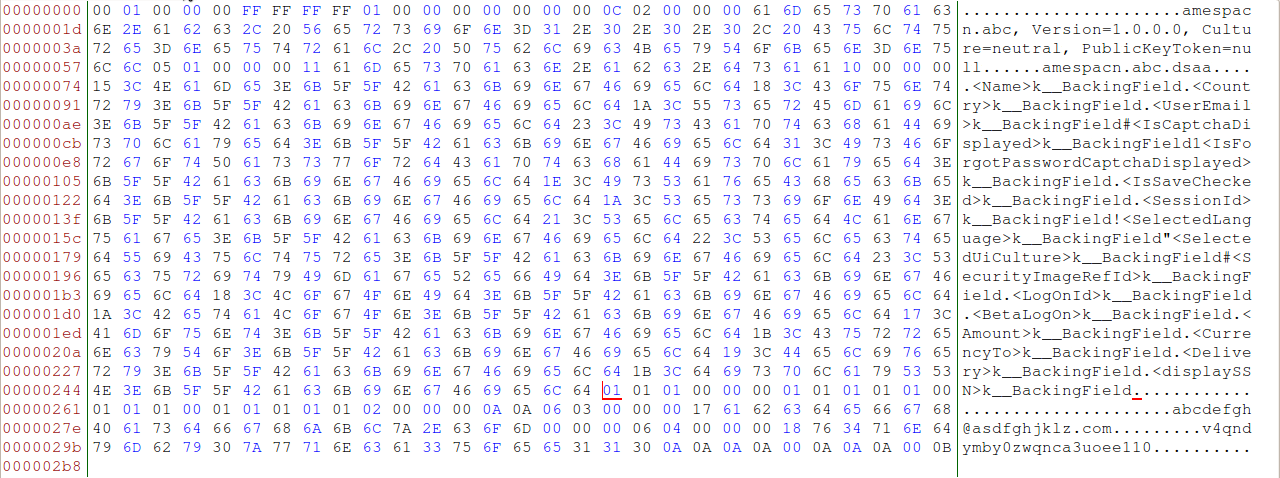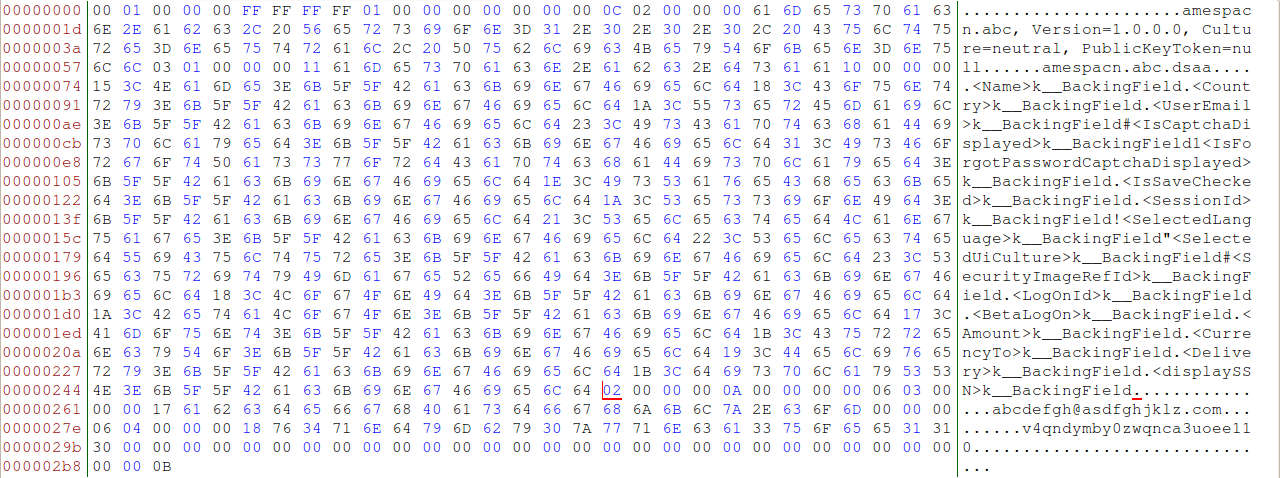Because it is maybe of interest for someone I decided to do this post about What does the binary format of serialized .NET objects look like and how can we interpret it correctly?
I have based all my research on the .NET Remoting: Binary Format Data Structure specification.
Example class:
To have a working example, I have created a simple class called A which contains 2 properties, one string and one integer value, they are called SomeString and SomeValue.
Class A looks like this:
[Serializable()]
public class A
{
public string SomeString
{
get;
set;
}
public int SomeValue
{
get;
set;
}
}
For the serialization I used the BinaryFormatter of course:
BinaryFormatter bf = new BinaryFormatter();
StreamWriter sw = new StreamWriter("test.txt");
bf.Serialize(sw.BaseStream, new A() { SomeString = "abc", SomeValue = 123 });
sw.Close();
As can be seen, I passed a new instance of class A containing abc and 123 as values.
Example result data:
If we look at the serialized result in an hex editor, we get something like this:
![Example result data]()
Let us interpret the example result data:
According to the above mentioned specification (here is the direct link to the PDF: [MS-NRBF].pdf) every record within the stream is identified by the RecordTypeEnumeration. Section 2.1.2.1 RecordTypeNumeration states:
This enumeration identifies the type of the record. Each record (except for MemberPrimitiveUnTyped) starts with a record type enumeration. The size of the enumeration is one BYTE.
SerializationHeaderRecord:
So if we look back at the data we got, we can start interpreting the first byte:
![SerializationHeaderRecord_RecordTypeEnumeration]()
As stated in 2.1.2.1 RecordTypeEnumeration a value of 0 identifies the SerializationHeaderRecord which is specified in 2.6.1 SerializationHeaderRecord:
The SerializationHeaderRecord record MUST be the first record in a binary serialization. This record has the major and minor version of the format and the IDs of the top object and the headers.
It consists of:
- RecordTypeEnum (1 byte)
- RootId (4 bytes)
- HeaderId (4 bytes)
- MajorVersion (4 bytes)
- MinorVersion (4 bytes)
With that knowledge we can interpret the record containing 17 bytes:
![SerializationHeaderRecord_Complete]()
00 represents the RecordTypeEnumeration which is SerializationHeaderRecord in our case.
01 00 00 00 represents the RootId
If neither the BinaryMethodCall nor BinaryMethodReturn record is present in the serialization stream, the value of this field MUST contain the ObjectId of a Class, Array, or BinaryObjectString record contained in the serialization stream.
So in our case this should be the ObjectId with the value 1 (because the data is serialized using little-endian) which we will hopefully see again ;-)
FF FF FF FF represents the HeaderId
01 00 00 00 represents the MajorVersion
00 00 00 00 represents the MinorVersion
BinaryLibrary:
As specified, each record must begin with the RecordTypeEnumeration. As the last record is complete, we must assume that a new one begins.
Let us interpret the next byte:
![BinaryLibraryRecord_RecordTypeEnumeration]()
As we can see, in our example the SerializationHeaderRecord it is followed by the BinaryLibrary record:
The BinaryLibrary record associates an INT32 ID (as specified in [MS-DTYP] section 2.2.22) with a Library name. This allows other records to reference the Library name by using the ID. This approach reduces the wire size when there are multiple records that reference the same Library name.
It consists of:
- RecordTypeEnum (1 byte)
- LibraryId (4 bytes)
- LibraryName (variable number of bytes (which is a
LengthPrefixedString))
As stated in 2.1.1.6 LengthPrefixedString...
The LengthPrefixedString represents a string value. The string is prefixed by the length of the UTF-8 encoded string in bytes. The length is encoded in a variable-length field with a minimum of 1 byte and a maximum of 5 bytes. To minimize the wire size, length is encoded as a variable-length field.
In our simple example the length is always encoded using 1 byte. With that knowledge we can continue the interpretation of the bytes in the stream:
![BinaryLibraryRecord_RecordTypeEnumeration_LibraryId]()
0C represents the RecordTypeEnumeration which identifies the BinaryLibrary record.
02 00 00 00 represents the LibraryId which is 2 in our case.
Now the LengthPrefixedString follows:
![BinaryLibraryRecord_RecordTypeEnumeration_LibraryId_LibraryName]()
42 represents the length information of the LengthPrefixedString which contains the LibraryName.
In our case the length information of 42 (decimal 66) tell's us, that we need to read the next 66 bytes and interpret them as the LibraryName.
As already stated, the string is UTF-8 encoded, so the result of the bytes above would be something like: _WorkSpace_, Version=1.0.0.0, Culture=neutral, PublicKeyToken=null
ClassWithMembersAndTypes:
Again, the record is complete so we interpret the RecordTypeEnumeration of the next one:
![ClassWithMembersAndTypesRecord_RecordTypeEnumeration]()
05 identifies a ClassWithMembersAndTypes record. Section 2.3.2.1 ClassWithMembersAndTypes states:
The ClassWithMembersAndTypes record is the most verbose of the Class records. It contains metadata about Members, including the names and Remoting Types of the Members. It also contains a Library ID that references the Library Name of the Class.
It consists of:
- RecordTypeEnum (1 byte)
- ClassInfo (variable number of bytes)
- MemberTypeInfo (variable number of bytes)
- LibraryId (4 bytes)
ClassInfo:
As stated in 2.3.1.1 ClassInfo the record consists of:
- ObjectId (4 bytes)
- Name (variable number of bytes (which is again a
LengthPrefixedString))
- MemberCount(4 bytes)
- MemberNames (which is a sequence of
LengthPrefixedString's where the number of items MUST be equal to the value specified in the MemberCount field.)
Back to the raw data, step by step:
![ClassWithMembersAndTypesRecord_RecordTypeEnumeration_ClassInfo_ObjectId]()
01 00 00 00 represents the ObjectId. We've already seen this one, it was specified as the RootId in the SerializationHeaderRecord.
![ClassWithMembersAndTypesRecord_RecordTypeEnumeration_ClassInfo_ObjectId_Name]()
0F 53 74 61 63 6B 4F 76 65 72 46 6C 6F 77 2E 41 represents the Name of the class which is represented by using a LengthPrefixedString. As mentioned, in our example the length of the string is defined with 1 byte so the first byte 0F specifies that 15 bytes must be read and decoded using UTF-8. The result looks something like this: StackOverFlow.A - so obviously I used StackOverFlow as name of the namespace.
![ClassWithMembersAndTypesRecord_RecordTypeEnumeration_ClassInfo_ObjectId_Name_MemberCount]()
02 00 00 00 represents the MemberCount, it tell's us that 2 members, both represented with LengthPrefixedString's will follow.
Name of the first member:
![ClassWithMembersAndTypesRecord_MemberNameOne]()
1B 3C 53 6F 6D 65 53 74 72 69 6E 67 3E 6B 5F 5F 42 61 63 6B 69 6E 67 46 69 65 6C 64 represents the first MemberName, 1B is again the length of the string which is 27 bytes in length an results in something like this: <SomeString>k__BackingField.
Name of the second member:
![ClassWithMembersAndTypesRecord_MemberNameTwo]()
1A 3C 53 6F 6D 65 56 61 6C 75 65 3E 6B 5F 5F 42 61 63 6B 69 6E 67 46 69 65 6C 64 represents the second MemberName, 1A specifies that the string is 26 bytes long. It results in something like this: <SomeValue>k__BackingField.
MemberTypeInfo:
After the ClassInfo the MemberTypeInfo follows.
Section 2.3.1.2 - MemberTypeInfo states, that the structure contains:
- BinaryTypeEnums (variable in length)
A sequence of BinaryTypeEnumeration values that represents the Member Types that are being transferred. The Array MUST:
Have the same number of items as the MemberNames field of the ClassInfo structure.
Be ordered such that the BinaryTypeEnumeration corresponds to the Member name in the MemberNames field of the ClassInfo structure.
- AdditionalInfos (variable in length), depending on the
BinaryTpeEnum additional info may or may not be present.
| BinaryTypeEnum | AdditionalInfos |
|----------------+--------------------------|
| Primitive | PrimitiveTypeEnumeration |
| String | None |
So taking that into consideration we are almost there...
We expect 2 BinaryTypeEnumeration values (because we had 2 members in the MemberNames).
Again, back to the raw data of the complete MemberTypeInfo record:
![ClassWithMembersAndTypesRecord_MemberTypeInfo]()
01 represents the BinaryTypeEnumeration of the first member, according to 2.1.2.2 BinaryTypeEnumeration we can expect a String and it is represented using a LengthPrefixedString.
00 represents the BinaryTypeEnumeration of the second member, and again, according to the specification, it is a Primitive. As stated above, Primitive's are followed by additional information, in this case a PrimitiveTypeEnumeration. That's why we need to read the next byte, which is 08, match it with the table stated in 2.1.2.3 PrimitiveTypeEnumeration and be surprised to notice that we can expect an Int32 which is represented by 4 bytes, as stated in some other document about basic datatypes.
LibraryId:
After the MemerTypeInfo the LibraryId follows, it is represented by 4 bytes:
![ClassWithMembersAndTypesRecord_LibraryId]()
02 00 00 00 represents the LibraryId which is 2.
The values:
As specified in 2.3 Class Records:
The values of the Members of the Class MUST be serialized as records that follow this record, as specified in section 2.7. The order of the records MUST match the order of MemberNames as specified in the ClassInfo (section 2.3.1.1) structure.
That's why we can now expect the values of the members.
Let us look at the last few bytes:
![BinaryObjectStringRecord_RecordTypeEnumeration]()
06 identifies an BinaryObjectString. It represents the value of our SomeString property (the <SomeString>k__BackingField to be exact).
According to 2.5.7 BinaryObjectString it contains:
- RecordTypeEnum (1 byte)
- ObjectId (4 bytes)
- Value (variable length, represented as a
LengthPrefixedString)
So knowing that, we can clearly identify that
![BinaryObjectStringRecord_RecordTypeEnumeration_ObjectId_MemberOneValue]()
03 00 00 00 represents the ObjectId.
03 61 62 63 represents the Value where 03 is the length of the string itself and 61 62 63 are the content bytes that translate to abc.
Hopefully you can remember that there was a second member, an Int32. Knowing that the Int32 is represented by using 4 bytes, we can conclude, that
![BinaryObjectStringRecord_RecordTypeEnumeration_ObjectId_MemberOneValue_MemberTwoValue]()
must be the Value of our second member. 7B hexadecimal equals 123 decimal which seems to fit our example code.
So here is the complete ClassWithMembersAndTypes record:
![ClassWithMembersAndTypesRecord_Complete]()
MessageEnd:
![MessageEnd_RecordTypeEnumeration]()
Finally the last byte 0B represents the MessageEnd record.
 The reserialized file: (zoom)
The reserialized file: (zoom)





















Data_reSerialized.datwillDeserializeand report what size itSerializeproduces; i.e. what size isData_reReSerialized.dat? – Fetterlock